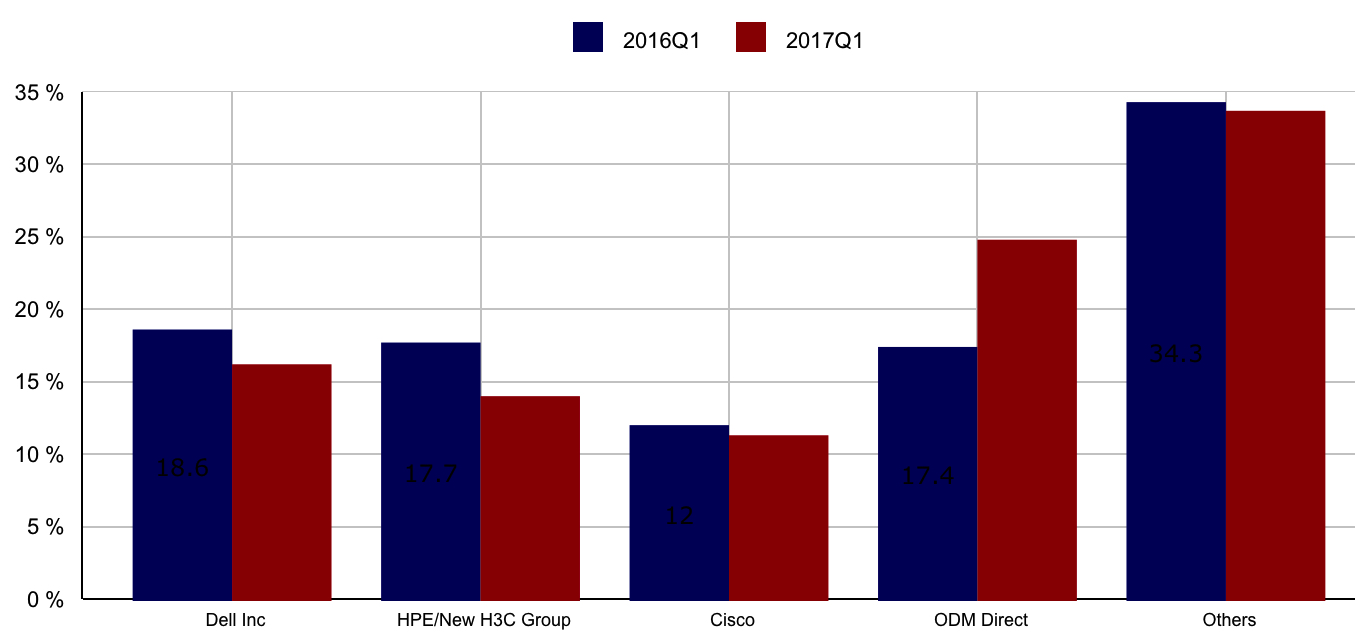Worldwide Cloud IT Infrastructure Revenue Up 15% to $8 Billion in 1Q17 – IDC
Top three are Dell, HPE and Cisco.
This is a Press Release edited by StorageNewsletter.com on July 5, 2017 at 2:56 pmAccording to the International Data Corporation‘s Worldwide Quarterly Cloud IT Infrastructure Tracker, vendor revenue from sales of infrastructure products (server, storage, and Ethernet switch) for cloud IT, including public and private cloud, grew 14.9% year over year in 1Q17, reaching $8 billion.
Cloud IT infrastructure sales as a share of overall worldwide IT spending climbed to 39% in 1Q17, a significant increase from 33.9% a year ago. Revenue from infrastructure sales to private cloud grew by 6.0% to $3.1 billion, and to public cloud by 21.7% to $4.8 billion. In comparison, revenue in the traditional (non-cloud) IT infrastructure segment decreased 8.0% year over year in the first quarter of the year. Private cloud infrastructure growth was led by Ethernet switch at 15.5% year-over-year growth, followed by storage (excluding double counting with servers) at 10.0% and server at 2.1%. Public cloud growth was led by storage, which after heavy declines in 1Q16 grew 49.5% year over year in 1Q17, followed by Ethernet switch at 22.7% and server at 8.7%. In traditional IT deployments, server declined the most (9.3% year over year), with Ethernet switch and servers declining 4.4% and 6.1%, respectively.
“After a weak performance during 2016, storage purchases for cloud IT environments had a strong rebound in the first quarter, driving the overall growth in this segment,” said Natalya Yezhkova, research director for enterprise storage, IDC. “Overall, the first quarter set a strong beginning of the year for the cloud IT infrastructure market. With positive dynamics in purchasing activity by hyperscalers across all technology segments we expect a strong year ahead for the fastest growing public cloud segment. And as end users continue to embrace the benefits of private cloud infrastructures, spending in this segment will also expand.”
From a regional perspective, vendor revenue from cloud IT infrastructure sales grew fastest in Canada at 59.1% year over year in 1Q17 off a small base (overall cloud IT infrastructure market in Canada was just under $100 million in 1Q17), followed by AsiaPac (excluding Japan) at 18.7%, Japan at 15.3%, the United States at 15.1%, Middle East and Africa at 13.2%, Western Europe at 8.9%, Latin America at 7.8%, and the Central and Eastern Europe at 7.2%.
Top 3 Vendor Group, WW Cloud IT Infrastructure Vendor Revenue, 1Q17
(revenue in $ million, excludes double counting of storage and servers)

WW Cloud IT Infrastructure Top 3 Cloud Vendors, 1Q17 vs. 1Q16
(shares based on vendor revenue)

(Source: IDC’s Worldwide Quarterly Cloud IT Infrastructure Tracker, June 2017)
Notes:
* IDC declares a statistical tie in the worldwide cloud IT infrastructure market when there is a difference of one percent or less in the vendor revenue shares among two or more vendors.
** Due to the existing joint venture between HPE and the New H3C Group, IDC will be reporting external market share on a global level for HPE as HPE/New H3C Group starting from Q2 2016 and going forward.
Taxonomy notes:
IDC defines cloud services more formally through a checklist of key attributes that an offering must manifest to end users of the service. Public cloud services are shared among unrelated enterprises and consumers; open to a largely unrestricted universe of potential users; and designed for a market, not a single enterprise. The public cloud market includes variety of services designed to extend or, in some cases, replace IT infrastructure deployed in corporate datacenters. It also includes content services delivered by a group of suppliers IDC calls Value Added Content Providers (VACP). Private cloud services are shared within a single enterprise or an extended enterprise with restrictions on access and level of resource dedication and defined/controlled by the enterprise (and beyond the control available in public cloud offerings); can be onsite or offsite; and can be managed by a third-party or in-house staff. In private cloud that is managed by in-house staff, ‘vendors (cloud service providers)’ are equivalent to the IT departments/shared service departments within enterprises/groups. In this utilization model, where standardized services are jointly used within the enterprise/group, business departments, offices, and employees are the ‘service users.’













 Subscribe to our free daily newsletter
Subscribe to our free daily newsletter

